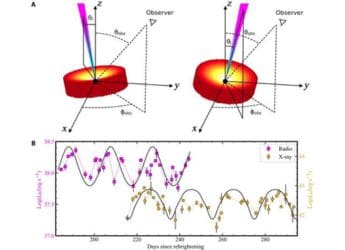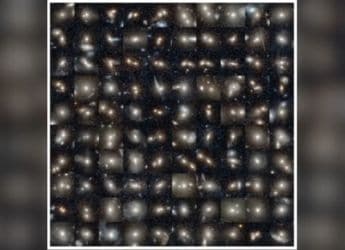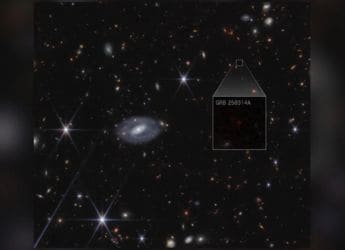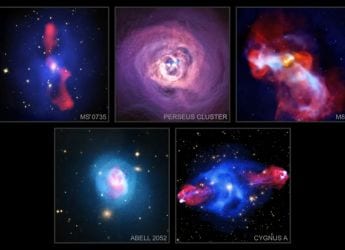- Home
- Science
- Science News
- Scientists Apply Stephen Hawking's Theory to Propose Detectable ‘Black Hole Morsels’ in Space
Scientists Apply Stephen Hawking's Theory to Propose Detectable ‘Black Hole Morsels’ in Space
Researchers suggest tiny ‘black hole morsels’ may reveal quantum gravity, detectable by today’s telescopes.

Photo Credit: wikimedia commons
Tiny ‘black hole morsels’ could shine light on quantum gravity using current detectors
Advanced theoretical research points out that tiny black holes born from violent cosmic collisions could provide a significant glance towards the quantum nature of space and time. This is also known as “black hole morsels,” these compact objects may release bursts of high-energy radiation — a phenomenon predicted by Stephen Hawking in the 1970s, that makes them significantly identifiable with existing gamma-ray observatories. When it confirmed, they may act as natural laboratories for exploring physics at energy scales far beyond the shadow of a doubt the reach of man-made particle accelerators.
Asteroid-Sized ‘Black Hole Morsels' Could Unveil Hidden Dimensions of the Universe
As per the study published in Nuclear Physics B, the concept draws on Hawking's insight that black holes emit faint radiation due to quantum effects near their event horizons. Smaller black holes emit significantly, and morsels formed during massive black hole mergers could be asteroid-sized yet considerably hotter. This accelerated temperature would make them evaporate quite fast, generating and releasing gamma rays and neutrinos that detectors such as HESS, HAWC, LHAASO, and the Fermi Gamma-ray Space Telescope could already be able to detect.
Researchers from the University of Southern Denmark, CNRS in France, and Institut de Physique des Deux Infinis de Lyon modelled how such morsels might form when instabilities during mergers pinch off small fragments of the parent black hole. The evaporation may produce a weird, delayed runaway release of fast particles in all directions that is distinct from the normal directed gamma-ray bursts. The problem is that earlier research has already started to leave limits on how we may see these types of phenomena by using data from current telescopes.
The team is working on refining formation models and partnering with researchers on targeted searches for exotic signals that may remarkably divulge hidden particles or extra dimensions. In addition to that, highlighting the potential for these signals to illuminate the night sky as well as teach about nature's laws.
Get your daily dose of tech news, reviews, and insights, in under 80 characters on Gadgets 360 Turbo. Connect with fellow tech lovers on our Forum. Follow us on X, Facebook, WhatsApp, Threads and Google News for instant updates. Catch all the action on our YouTube channel.
- Samsung Galaxy Unpacked 2025
- ChatGPT
- Redmi Note 14 Pro+
- iPhone 16
- Apple Vision Pro
- Oneplus 12
- OnePlus Nord CE 3 Lite 5G
- iPhone 13
- Xiaomi 14 Pro
- Oppo Find N3
- Tecno Spark Go (2023)
- Realme V30
- Best Phones Under 25000
- Samsung Galaxy S24 Series
- Cryptocurrency
- iQoo 12
- Samsung Galaxy S24 Ultra
- Giottus
- Samsung Galaxy Z Flip 5
- Apple 'Scary Fast'
- Housefull 5
- GoPro Hero 12 Black Review
- Invincible Season 2
- JioGlass
- HD Ready TV
- Laptop Under 50000
- Smartwatch Under 10000
- Latest Mobile Phones
- Compare Phones
- Redmi Note 15 5G
- Redmi Note 15 Pro 5G
- Redmi Note 15 Pro+ 5G
- Lava Play Max
- Poco C85 5G
- Honor Magic 8 Lite
- Jolla Phone
- Realme P4x 5G
- Asus ProArt P16
- MacBook Pro 14-inch (M5, 2025)
- OnePlus Pad Go 2
- Poco Pad M1
- Just Corseca Skywatch Pro
- Honor Watch X5
- Acerpure Nitro Z Series 100-inch QLED TV
- Samsung 43 Inch LED Ultra HD (4K) Smart TV (UA43UE81AFULXL)
- Asus ROG Ally
- Nintendo Switch Lite
- Haier 1.6 Ton 5 Star Inverter Split AC (HSU19G-MZAID5BN-INV)
- Haier 1.6 Ton 5 Star Inverter Split AC (HSU19G-MZAIM5BN-INV)












